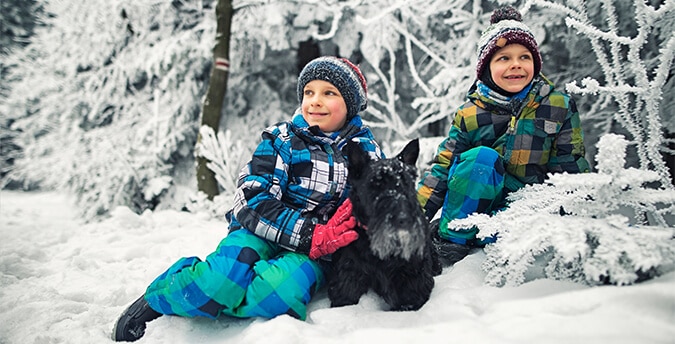Don’t Let Your Dog Fall Victim to Cold Weather

The cold weather has most of us uncomfortable, shivering, and suffering from various illnesses. While many of us know how to keep ourselves and our children warm, we also want to do the same for our dogs.
Many people might think that their dog already has a permanent fur coat, but that doesn’t mean they don’t need some extra help in the cold season. Here are some tips on keeping your canine warm and secure when it’s cold:
WHEN TO TAKE ACTION
Don’t think that your pet is automatically warmer than you just because they have fur lining their body. Think of that fur as their skin, or their clothing, which may not be enough to protect them from the elements. The general rule of thumb for the cold season is that if you’re feeling cold, your pet’s probably feeling the same.
When the temperatures start plummeting, you should keep your dog indoors as much as possible. If they’re more an outdoors kind of dog, you might look into giving them a heated dog house or add heater to their dog house that won’t harm them. If you don’t take these steps, your dog might contract pneumonia or hypothermia.
If you have to go out and leave your dog alone at home, set the heating to at least 68 degrees Fahrenheit (20 degrees Celsius). This would ensure that they don’t get too cold while waiting for you to come home.
SHORT AND REGULAR WALKS
Dogs need walks year round in order to use up their energy. When the weather starts getting colder, though, you don’t want to have them outside for too long. On the other hand, you still want them to get as much exercise as possible. Getting enough blood flowing in their veins is also an important factor for keeping your dog warm.
The solution to this is to take them on short walks more often. This would help them get their fill of the outdoors without putting them at risk. If your dog is small, consider getting them a warm vest or jacket to wear outdoors.
After your dog has been outside to walk, run, or play in the winter, make sure that you wash their feet and dry them immediately. There are all kinds of salts, chemicals, and antifreeze on the road where there’s snow. This could irritate the pads on a pet’s feet and possibly add to the likelihood of their getting ill.
STUDY THE BREED
If you have a specific breed, you might have to look up whether they can handle the winter or need some more care than usual. For instance, a Husky may not need so much protection from the cold weather, which is why they’re a great pet for such climates. However, a Great Dane, a Doberman, or a Chihuahua might need some extra care in this season.
Overall, if your pet has a somewhat short nose, they can suffer from breathing difficulties in the winter. You may hence have to take extra care to keep them from getting the sniffles or sinus issues during this time.
FEEDING
It’s important to give your dog proper meals in any case, but even more important to increase their calories in the winter. They would need the extra energy in order to generate the necessary heat or exercise to stay warm. However, you also want to be careful not to overfeed your dog, which could lead to other problems. Consult your vet for the best possible diet plan to get your dog safely through the winter.
Don’t ignore the hydration factor, either. Your dog should have a ready supply of fresh water, especially when the temperature is extreme either way.
CONCLUSION
Keeping a dog warm when it’s snowing or chilly outside is necessary for their health. If you don’t take the proper preventative steps, your pet could end up drastically sick. Such illnesses could also be fatal, especially if the dog is on the small side.
A few steps in the right direction could easily prevent the cold from getting at your beloved dog. They’re your responsibility and part of your family, so make up a list of what you need to get them through the winter!
